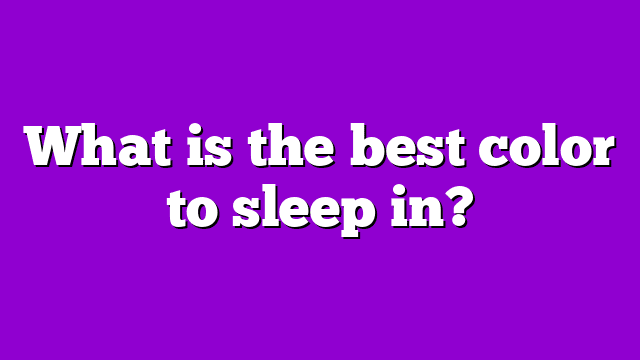Crystal Fashion & Jewelry
What is the best color to sleep in?
When it comes to getting a good night’s sleep, the color of your bedroom walls can actually make a difference in how well-rested you feel in the morning. The best color to sleep in is a calming, soothing tone that helps to promote relaxation and reduce stress. Research has shown that certain colors have a greater impact on our emotions and mood than others, and choosing the right shade for your bedroom can be a key factor in promoting better sleep habits.
Some of the best colors to sleep in include:
- Soft, muted blues and greens are ideal for creating a calm and tranquil atmosphere. These shades promote relaxation and can help to lower blood pressure and heart rate, which can lead to a more restful sleep.
- Eartones such as beige, tan, and light brown can have a grounding and calming effect, making them a good choice for promoting sleep.
On the other hand, certain colors can actually increase anxiety and make it harder to fall asleep. These colors include:
- Bright, bold colors such as red, yellow, or orange can be overstimulating and too energizing for the bedroom, making it harder to fall asleep or stay asleep.
- Cool colors such as black, gray or white could make the atmosphere feel too stark and uninviting, leading to a more anxious state of mind.
In conclusion, the best color to sleep in is subjective to the individual, as different people have different preferences and psychological reactions to certain colors. However, choosing a calming and soothing color palette over a bold and bright one is a good start for anyone looking to improve their sleep quality.
Table Of Contents
The Relationship Between Color and Sleep Quality
Impact of Color on Sleep
Color can impact a person’s mood, behavior, and overall health. It can also affect sleep quality. Understanding the psychology of color and the power it holds over our emotions can help us choose the right environment for sleep. Researchers say that colors can influence sleep and have different effects on our body and mind. More specifically, colors can stimulate our brainwaves in different ways and activate various sensory receptors in our body.
Importance of Choosing the Right Color for Sleeping
Sleep quality is imperative for health and wellness. The right color plays a crucial role in ensuring a restful night. The color of the walls, bedding, curtains, and furnishings in your bedroom can either promote or dampen your sleep quality. Therefore, it is vital to choose colors that create a relaxing and calm sleeping environment. The right color palette can help the brain understand that it’s time for sleep, leading to faster and better sleep.
Best Colors for a Good Sleep
The best colors for sleep are muted hues that promote calmness and relaxation. Research shows that colors such as blue, green, and lavender have a calming effect on the body and can help to reduce stress and anxiety levels. Additionally, neutral colors such as beige or light gray can be soothing and create a peaceful environment.
Here are some other colors that are great for promoting sleep:
• Pastel shades of pink
• Soft shades of yellow
• Earthy tones such as browns
Worst Colors for Sleep Quality
Dark, bright, or vivid colors can hinder sleep quality. These colors can be stimulating and energy-boosting, leading to a lack of sleep. Colors such as bright reds, yellows, and oranges are known to be energizing and can affect a person’s mood causing them to remain alert and awake for a longer time. Similarly, black and other dark shades can make a room feel constrictive and claustrophobic.
Here are some other colors that can hamper sleep quality:
• Bright blues and greens
• Bold shades of pink and purple
• Shades of red and orange
Effects of Colors on Anxiety Levels
We all experience anxiety differently, and colors can impact our anxiety levels. Studies suggest that color therapy can help reduce anxiety levels and alleviate stress. Similarly, the right color scheme in the bedroom can help promote relaxation and lower stress levels. Creating a bedroom environment that uses calming colors can help to lower anxiety, leading to improved sleep quality.
Colors That Can Increase Anxiety
Vivid and bold colors such as bright yellows, oranges, and reds can increase anxiety levels. Similarly, gray shades, especially dark shades, can have a dampening impact on mood, leading to feelings of sadness and anxiety. Designers recommend avoiding these colors in areas of the home such as the bedroom, and instead opt for calming and soothing colors.
In conclusion, the colors we surround ourselves with can significantly impact our sleep quality and overall health. Understanding how color impacts our emotions can help create the bedroom environment we need to rest and rejuvenate. Opting for muted hues such as blues, greens, and pastels promotes calmness and relaxation, leading to better sleep quality. Avoiding dark, bright, and vivid colors can help reduce energy levels and promote calmness, leading to improved sleep and reduced anxiety.

